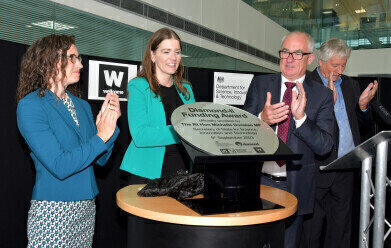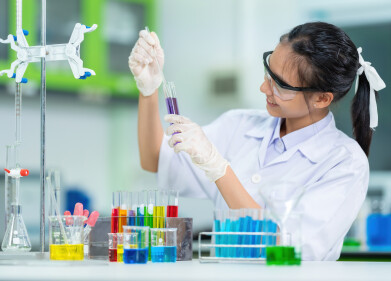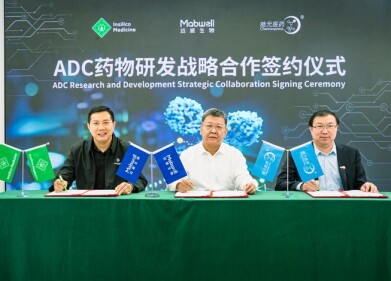-
 The celebratory plaque for the funding announcement for Diamond-II is unveiled. L to R: Beth Thompson MBE Chief Strategy Officer at Wellcome, Secretary of State for Science, Innovation and Technology, the Rt Hon Michelle Donelan MP, Executive Chair of STFC Professor Mark Thomson, and Sir Adrian Smith, Chair of the Board of Diamond (Credit: Diamond Light Source)
The celebratory plaque for the funding announcement for Diamond-II is unveiled. L to R: Beth Thompson MBE Chief Strategy Officer at Wellcome, Secretary of State for Science, Innovation and Technology, the Rt Hon Michelle Donelan MP, Executive Chair of STFC Professor Mark Thomson, and Sir Adrian Smith, Chair of the Board of Diamond (Credit: Diamond Light Source) -
 Sarnjeet Dhesi, Science Group Leader for Diamond's Magnetic Materials group explains the science of new beamline upgrades part of Diamond-II with David Burn, Principal Beamline Scientist (CSXID) (Credit: Diamond Light Source)
Sarnjeet Dhesi, Science Group Leader for Diamond's Magnetic Materials group explains the science of new beamline upgrades part of Diamond-II with David Burn, Principal Beamline Scientist (CSXID) (Credit: Diamond Light Source)
Company news
Launch Event signals Diamond II Upgrade
Oct 16 2023
A visit to Diamond Light Source, the UK’s national synchrotron by Secretary of State for Science, Innovation and Technology, Michelle Donelan, officially started the programmed upgrade to Diamond II, a £519 million UK government investment predominantly from the UK Research and Innovation (UKRI) Infrastructure Fund (86%) and the Wellcome Trust (14%).
The investment will involve construction of a new, even brighter synchrotron machine, essentially a giant microscope producing light 10 billion times brighter than the sun. The work at Diamond, based at the Science and Technology Facilities Council (STFC) Rutherford Appleton Laboratory, is expected to complete in 2030.
Science, Innovation and Technology Secretary, Michelle Donelan, said: “Our national synchrotron may fly under the radar as we go about our daily lives, but it has been crucial to some of the most defining discoveries in recent history – from kickstarting Covid drug development that allowed us to protect millions to advancing treatment for HIV.
“Our investment will ensure one of the most pioneering scientific facilities in the world continues to advance discoveries that transform our health and prosperity, while creating jobs, growing the UK economy and ensuring our country remains a scientific powerhouse.
She also highlighted the wide-reaching impact that Diamond-II will likely have on diverse scientific fields including:
- pharmaceutical development building on the contribution Diamond made to COVID-19 vaccination research
- physical sciences including the discovery of new materials for the renewable industry
- technological development for various industries including sustainable tech for the net zero agenda
Diamond-II is also expected to support the facility’s already considerable contribution to the UK economy. Since operations began in 2007, the economic and social impact of Diamond is estimated to be worth at least £2.6 billion, showing a significant return on the £1.4 billion public investment to date.
Visitors to the launch event held in September included Professor Sir Adrian Smith, Chair of Diamond and President of the Royal Society, Professor Mark Thomson, STFC Executive Chair, Dr Beth Thompson, Chief Strategy Officer at Wellcome and members from the research and innovation community.
Professor Mark Thompson said: “The UK is home to incredibly talented researchers, but this alone is not sufficient to stay at the forefront of globally competitive science. It is essential that we also invest in world-class research infrastructure programmes that provide our researchers with the necessary tools to work at the cutting edge.
“This investment in Diamond-II will play a crucial role in cementing the UK’s place as a Science Superpower and provide our talented researchers and innovators with the best opportunities to make major breakthroughs across a wide range of disciplines from structural biology to advance materials and battery technologies.”
Sir Adrian Smith added: “We are securing the next decades for Diamond through this upgrade which is due to be delivered by 2030. We are entering a new era of opportunity with the advent of fourth generation synchrotrons. This will be a massive transformation of our capabilities. Progress in accelerator technology means Diamond-II will offer the scientific community in academia and industry the opportunity to exploit much brighter beams and an increased coherence over a large energy range on all our beamlines plus additional beamlines. It will help inspire the next generation of STEM professionals and create new opportunities for researchers in universities, research institutes and industry, ultimately having a lasting impact on our society and the economy.
UKRI’s commitment to Diamond is part of the £481m UKRI has allocated to infrastructure within the UKRI portfolio between 2022 and 2025 for 23 major infrastructure projects and 9 scoping studies to maintain the UK’s position as a science superpower.
More information online
Digital Edition
Lab Asia Dec 2025
December 2025
Chromatography Articles- Cutting-edge sample preparation tools help laboratories to stay ahead of the curveMass Spectrometry & Spectroscopy Articles- Unlocking the complexity of metabolomics: Pushi...
View all digital editions
Events
Jan 21 2026 Tokyo, Japan
Jan 28 2026 Tokyo, Japan
Jan 29 2026 New Delhi, India
Feb 07 2026 Boston, MA, USA
Asia Pharma Expo/Asia Lab Expo
Feb 12 2026 Dhaka, Bangladesh


















